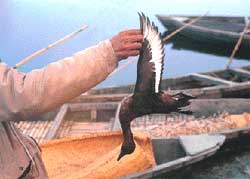The vanishing lakes
 The Sahanis are known as "masters of water'. This fishing community had been living in the wetlands of north Bihar for aeons, relying on them for sustenance. They did so by fishing or helping people cross the surging rivers that crisscross the floodplain. Or by displaying their art of trapping birds. They often got invites from faraway places such as Chilika in Orissa and Keoladeo National Park in Rajasthan to ensnare birds for scientific purposes. But now their skill no longer protects them from hard times. The lakes have been drained. As a result, the fish stocks have reduced drastically, and the birds have stopped visiting them. Most of the community members have already ventured out to do what their forefathers never did: work as labourers in faraway places like Delhi and Punjab.
The Sahanis are known as "masters of water'. This fishing community had been living in the wetlands of north Bihar for aeons, relying on them for sustenance. They did so by fishing or helping people cross the surging rivers that crisscross the floodplain. Or by displaying their art of trapping birds. They often got invites from faraway places such as Chilika in Orissa and Keoladeo National Park in Rajasthan to ensnare birds for scientific purposes. But now their skill no longer protects them from hard times. The lakes have been drained. As a result, the fish stocks have reduced drastically, and the birds have stopped visiting them. Most of the community members have already ventured out to do what their forefathers never did: work as labourers in faraway places like Delhi and Punjab.
The chaurs (tectonic depressions), mauns (oxbow lakes) and freshwater bodies that dot north Bihar were previously inundated by overflow from the rivers and local monsoon runoff. Their principal function was to act as sponges and they were nature's own initiative at flood control. Human intervention has seriously impaired this function. Setting up of embankments, roads and railways, have contributed considerably to waterlogging. Reclamation of depressions has compounded the problem.
According to A K Narayanan, former director (conservation and survey) in the ministry of environment and forest (MEF), India has about 4.1 million hectares (mha) of wetlands
Related Content
- Vembanad lake may vanish in 50 years: study
- Greens warn of vanishing wetlands in the city
- Heavy rainfall can flood north Bengaluru: IISC study
- Rare amphibians and reptiles vanish after Jagdishpur lake is dried up
- Lakes‚ ponds in Bajura on verge of extinction
- Palike finds way to check growth of weeds in City lakes
